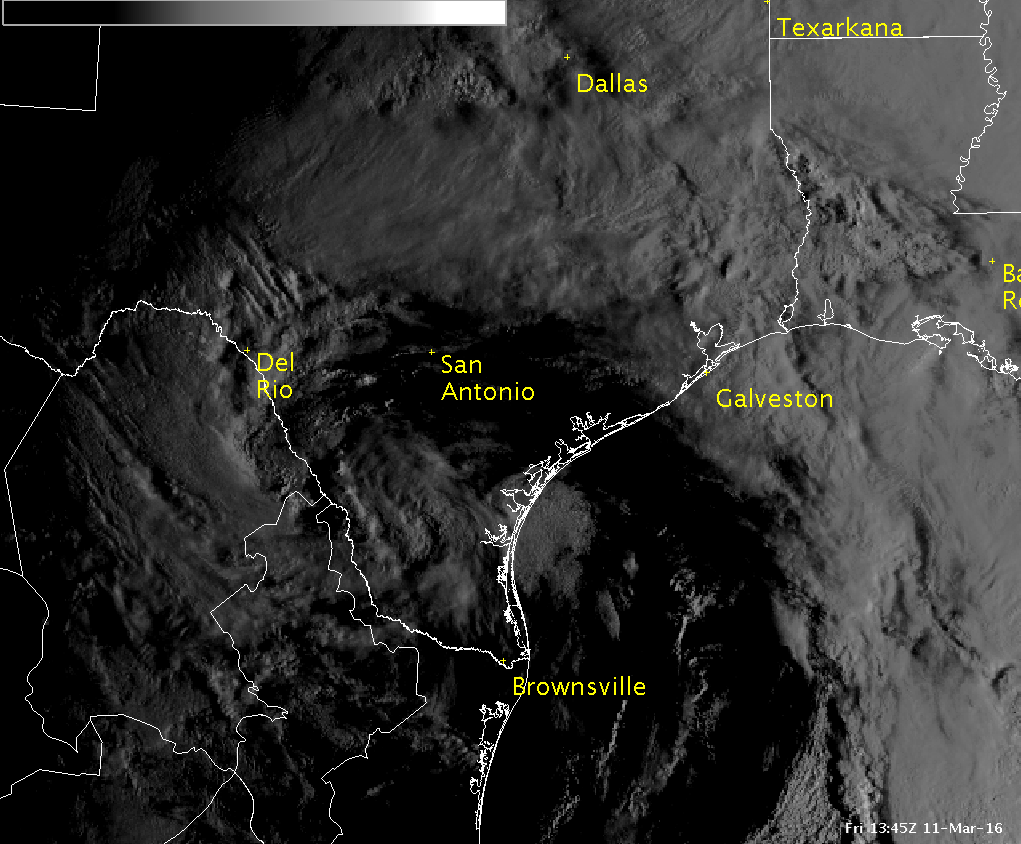 Visible Satellite loop from the morning of March 11, 2016, of atmospheric cyclone moving across Deep South Texas |
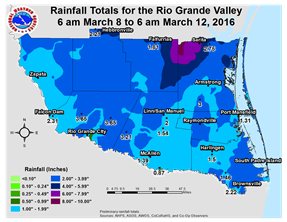 Accumulated rainfall for March 8th through 11th 2016 for the Rio Grande Valley (click for full size) |
||||||||||||||||||||||||||||||||||||||||||||||||||||||||||||||||||||||||||||||||||||||||||||||||||||||||||||||||||||||||||||||||||||||||
| Flash Drought, Wiped Out! Rainy, Unsettled Weather March 8–11, 2016 Settles the Dry Score |
|||||||||||||||||||||||||||||||||||||||||||||||||||||||||||||||||||||||||||||||||||||||||||||||||||||||||||||||||||||||||||||||||||||||||
|
After a winter when the El Niño wet and cool forecast failed to materialize, spring, albeit briefly, had other ideas. A single atmospheric cyclone, with origins in the East–Central Pacific Ocean north of the more typical subtropical zone where El Niño–borne cyclones form, took a sharp dive into Mexico – Central Mexico on March 9th and 10th, before curling across the Valley on March 11th and dissipating into the strong westerly flow in northeast Texas on the 12th. The deep, non–tropical cyclone, which for some became known as the "Mayan Express" due to its peak intensity in Mexico, produced widespread and in some cases record flooding rains across Louisiana and east Texas and snow as far south as Zacatecas State in central Mexico at 7 thousand foot elevation! There were at least six related fatalities in east Texas and Louisiana directly or indirectly from the floods as of mid March. For the Rio Grande Valley, the system produce drought–relieving rains, but did create a few headaches along the way. 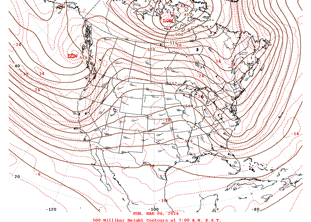 Atmospheric non–tropical cyclone evolution at around 18,000 feet (500 mb pressure) from March 6 through 13, 2016. Note the originating location over the eastern Pacific, well north of the subtropics where typical El Niño disturbances form. The southward extent of the system was very rare, but similar systems have occurred in other winters and springs, El Niño or not. Rainfall 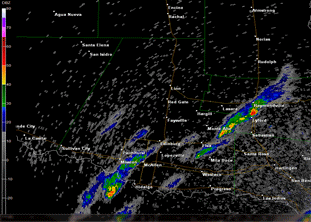 Radar loop of 0.5° reflectivity for rapid development of a band of thunderstorms between 5 and 717 AM CST, mainly across Hidalgo County Texas. Pixels in pink or purple likely indicated sufficient hail to reach the ground. |
Rainfall, Continued 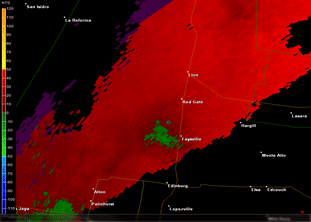 Radar loop of 0.5° velocity for a band of thunderstorms between 618 and 717 AM CST, March 9th 2016, centered near Linn, Texas. 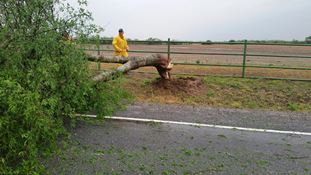 Photo of uprooted, newly–leafed mesquite tree along FM 1017 just west of Linn, Texas, early on March 9, 2016 Damaging Wind and Hail Still, some cells along the line were able to sustain enough updraft to produce hail, which fell briefly in spots across the McAllen/Edinburg area, with a few reports of half inch to quarter sized hail just before 6 AM. Sometime between 630 and 7 AM, one cell was able to drop an estimated 65 mph wind gust on the small town of Linn, where a power pole fell and several mesquite trees were uprooted along FM 1017 just west of the U.S. 281/IH 69C expressway. The cells would further consolidate into a line west of Linn and extend toward La Joya before lifting out by 9 AM. |
||||||||||||||||||||||||||||||||||||||||||||||||||||||||||||||||||||||||||||||||||||||||||||||||||||||||||||||||||||||||||||||||||||||||
ASOS=NWS Automated Surface Observing System
Cooperative=NWS Cooperative Observing Climate Network CoCoRaHS=Community Collaborative Rain, Hail, and Snow Network Mesowest/RAWS=University of Utah sponsored network, including Remote Automated Weather Station AWOS=Automated Weather Observing System (Managed by FAA) |
|||||||||||||||||||||||||||||||||||||||||||||||||||||||||||||||||||||||||||||||||||||||||||||||||||||||||||||||||||||||||||||||||||||||||